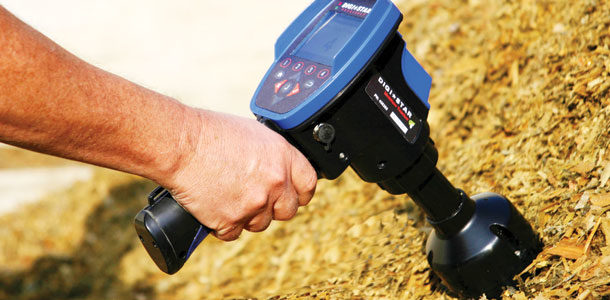High-performing dairy cows thrive on consistency and routine, from a quiet and comfortable pen environment and consistent milking times to a stable and nutritious TMR delivered at the same times each day. Dairy owners, managers and consultants have long recognized that the foundation of a nutrition program is measuring moisture. However, accurately and quickly assessing moisture for a variety of forages and feeds remains a challenging task.
How does a moisture change impact your herd?
Cows’ nutritive requirements are met with pounds of dry matter, not water. Moisture changes caused by rain events or variability in silos have been clearly documented to impact performance.
Researchers recently found that moisture changes similar to a rain event led to a 2- to 3-pound per cow drop in performance for several days. This performance equates to $1.20 to $1.80 per cow over that timespan.
In addition to performance challenges, forage moisture that is more than expected can also increase the amount of concentrate (and cost) in the diet. Researchers at Ohio State found that on commercial dairies, corn silage moisture variation (standard deviation) is between 2 and 3 percentage units. Using this valuable information, we’ve shown ( Tables 1 and 2 ) what a normal corn silage moisture swing can have on diet cost.


The differences in the expected versus the actual corn silage moisture are shown in yellow (65 versus 67.7 percent). This difference is well within “normal” day-to-day variation. The moisture impact on actual ingredient intake is shown in orange.
Notice the cows are eating over 1 pound less corn silage dry matter; however, the cows still eat 53 pounds of overall TMR. Because of greater moisture, missing corn silage is replaced in the diet with alfalfa, corn and expensive protein and mineral mix.
Figure 1 represents the formulated high-producing cow diet, with expected feed dry matters, intakes and feed costs per cow. Figure 2 shows the actual diet, intakes and feed costs after a realistic 2.7 percent unit moisture change in corn silage.

The cost increase ($7.83 versus $7.58) from this slight moisture change is $0.25 per cow per day. These unseen costs quickly add up across 100, 500 or 1,000 cows. Beyond the example shown here, a 1,250-cow dairy also told me that monitoring moisture daily would allow them to cut refusals back from 5 percent to 1 percent. The owner calculated the decreased refusals would save his dairy $275 per day in feed cost.
Monitoring moisture daily is critical as we strive for consistent and precise nutrition programs. Margins over feed cost are too slim to not capture this hidden profit.
The science behind an NIR moisture meter
Food dehydrator, oven and microwave moisture measures can be reasonably accurate ways to measure moisture; however, they take substantial time, and running several samples per day or week can be challenging. The quickest and most efficient way to measure and track multiple ingredients’ moisture across your silo, bunker, pit or pile is with an NIR moisture meter.

Near-infrared reflectance spectroscopy (NIR) is a tried and proven technology for measuring moisture and other nutrition parameters. Light is bounced off the forage, and some is reflected back. The reflected light is related to the moisture content, and with extensive calibration, these tools are capable of measuring moisture to within 1 percent.
We have worked with this technology for more than 30 years, and have developed the calibrations behind the industry’s newer hand-held tools. The units were calibrated by first measuring moisture levels for many feeds and then relating moisture values to light-reflectance data. The reference measure is drying feeds for 48 hours in a 50ºC forced-air oven. The meter was accurate to within 1 percent.
In a validation test, we analyzed oven-measured moisture against moisture meter predicted values (Figure 1). The results showed better than 99 percent agreement and confirmed that you can be confident in moisture results plus or minus 1 percent.
Updating moisture on the go
With the industry’s innovative NIR moisture tools, data can be tracked daily for a number of feeds at once and imported directly into TMR software.
Imagine this scenario: Your dairy’s feed manager can begin the day by opening up or defacing silos and forages, taking moisture measures for all forages and wet feeds and then automatically updating and uploading correct moistures into feed management software. Beyond accurate daily feeding, the meters are also valuable during the harvest season to determine fresh-crop moistures.
The process for measuring the moistures of many feeds at once can be completed within minutes. The meter focuses on moisture, but moisture fluctuations alone can cost thousands. Your dairy can gain an edge in precision feeding and reduce excess feed costs by dialing in moisture more frequently.
Return on your investment for your farm can be estimated using some of the data referenced here. Work with your consulting team to determine if these tools fit your dairy and nutrition program. PD
John Goeser earned a Ph.D. in animal nutrition from the University of Wisconsin – Madison and directs animal nutrition, research and innovation efforts at Rock River Lab Inc. based in Watertown, Wisconsin. Don Meyer is president of Rock River Lab Inc.
References omitted due to space but available upon request. Click here to email an editor.
PHOTOS
Imagine this scenario: Your dairy’s feed manager can begin the day by opening up or defacing silos and forages, taking moisture measures for all forages and wet feeds and then automatically updating and uploading correct moistures into feed management software. Photos courtesy of John Goeser.

John Goeser
Director of Nutrition, Research and Innovation
Rock River Laboratory Inc.






